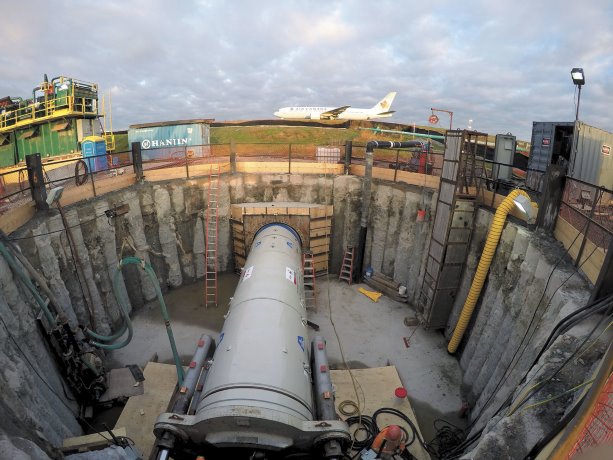After three years of design, numerous regulatory approvals and an intensive tunnelling operation last fall under Canada’s busiest airport runway, the missing link in the twinning of Peel Region’s Etobicoke Creek Trunk Sanitary Sewer has been connected and is now operational.
Designed by consultant and contract administrator Hatch Mott MacDonald (now Hatch), the slurry micro-tunnel installation of 576 metres of concrete pipe right through Pearson International Airport completes the trunk sewer twinning, which regional officials needed to divert flows in case of emergencies and to provide additional capacity for new growth.
The $16.7-million project consisted of a slurry micro-tunnelling operation and the hydraulic jacking installation of the 1,800-millimetre pipe about eight to 10 metres below Runway 23 and two adjacent taxiways. It was carried out by the Dibco Underground/CRS Tunnelling Inc. joint venture which worked around the clock seven days a week from October to December 2015.
There was no room for an intermediate shaft and the work could not interfere with the runway’s operation, says Peel Region project manager Ajay Puri, as he touched on just some of the project’s numerous complexities.
The planning, design and approval steps leading up to the construction were just as complicated, he points out.
Sometime before Peel Region was created in the early 1970s, the original Etobicoke Creek sanitary sewer was built through the airport by the Ministry of the Environment. Then, in the 1990s, the need for a twin was identified in a master plan and since the early 2000s the region has been building it from Dundas Street south to Highway 407.
"This (the airport) was the most logical place," says Puri of the decision to complete the last section right through — or more precisely underneath the property.
Of course, bridging that gap required obtaining all the approvals of the Greater Toronto Airports Authority, with ultimate approval by Nav Canada, the privately run, not-for-profit corporation that owns and operates Canada’ s civil air navigation system.
Design work started in 2012 and wasn’t completed until 2015, as the design had to be submitted to the airports authority at the 30 per cent, 60 per cent, 90 per cent and then 100 per cent completion stages, Puri says. As the designated launch shaft was in a conservation restricted area, the region also had to obtain a Toronto Region Conservation Authority permit and ensure there would be no construction impact on a nearby tributary of the Etobicoke Creek, he says.
"Then we had to wait until we got into the queue," says Puri, explaining the region still had to wait several months before it received final approval to proceed. This interim period was used to prequalify contractors, with the nod going to the Dibco/CRS joint venture, which came on site in July 2015.
As would be expected at a federal government-owned facility, security was a top issue and concern. Every vehicle entering the airport property had to be inspected and then escorted directly to and from the construction site.
"Once we got used to it (the security procedures), that was not a problem," he says.
Major commitments the region made at the outset of the project included a promise that there would be ground settling problems and no long-term work disruptions to the airport. The team was able to keep those promises, says Puri.
Although the tunnelling was completed last December, the joint venture remained on site until early June completing post-excavation tasks such as the construction of four manholes, improvements two existing ones, modifications to a diversion chamber and restoration work, he says.
Servicing the eastern portion of Peel Region, as well as receiving some wastewater flow from York Region, the Etobicoke sanitary sewer is one of two of its kind operated by the region. The second one is the Credit Valley or west trunk, says Puri.






Recent Comments
comments for this post are closed